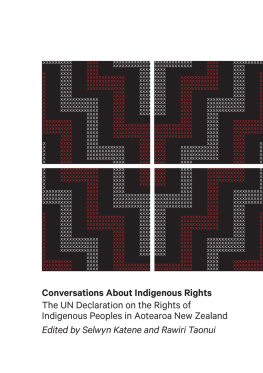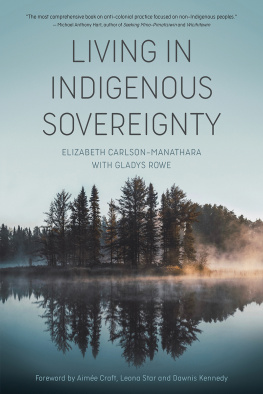The Right Relationship
Reimagining the Implementation of Historical Treaties
Edited by John Borrows and Michael Coyle
University of Toronto Press
Toronto Buffalo London
University of Toronto Press 2017
Toronto Buffalo London
www.utppublishing.com
Printed in Canada
ISBN 978-1-4426-3020-8 (cloth) ISBN 978-1-4426-3021-5 (paper)
 Printed on acid-free, 100% post-consumer recycled paper with vegetable-based inks.
Printed on acid-free, 100% post-consumer recycled paper with vegetable-based inks.
Library and Archives Canada Cataloguing in Publication
The right relationship : reimagining the implementation of historical treaties/edited by John Borrows and Michael Coyle.
Includes bibliographical references and index.
ISBN 978-1-4426-3020-8 (cloth). ISBN 978-1-4426-3021-5 (paper)
1. Native peoples Canada Government relations. 2. Native peoples Legal status, laws, etc. Canada. I. Borrows, John, 1963, author, editor II. Coyle, Michael, 1960, author, editor
E92.R54 2017 971.004'97 C2016-906253-8
University of Toronto Press acknowledges the financial assistance to its publishing program of the Canada Council for the Arts and the Ontario Arts Council, an agency of the Government of Ontario.

THE RIGHT RELATIONSHIP
Reimagining the Implementation of Historical Treaties
The relationship between Canadas Indigenous peoples and the Canadian government is one that has increasingly come to the fore. Numerous tragic incidents, a legacy of historical negligence, and more vehement calls for action are forcing a reconsideration of the relationship between the federal government and Indigenous nations.
In The Right Relationship, John Borrows and Michael Coyle bring together a group of renowned scholars, both Indigenous and non-Indigenous, to cast light on the challenges Canadians face in seeking a consensus on the nature of treaty partnership in the twenty-first century. The diverse perspectives examine how Indigenous peoples own legal and policy frameworks can be used to develop healthier attitudes between First Peoples and settler governments in Canada. While considering the existing law of Aboriginal and treaty rights, the contributors imagine what these relationships might look like if those involved pursued our highest aspirations as Canadians and Indigenous peoples. This timely and authoritative volume provides answers that will help pave the way towards good governance for all.
JOHN BORROWS is the Canada Research Chair in Indigenous Law in the Faculty of Law at the University of Victoria and is the winner of both the Canadian Political Science Associations Donald Smiley Prize (for Recovering Canada) and the Canadian Law and Society Association Book Prize (for Canadas Indigenous Constitution).
MICHAEL COYLE is an associate professor and Director of Graduate Programs in the Faculty of Law at Western University. He has over twenty-five years of experience in mediating disputes between the Crown and First Nations.
Contents
MICHAEL COYLE AND JOHN BORROWS
JOHN BORROWS
MICHAEL COYLE
KENT MCNEIL
JULIE JAI
FRANCESCA ALLODI-ROSS
SARI GRABEN AND MATTHEW MEHAFFEY
MARK D. WALTERS
AARON MILLS
HEIDI KIIWETINEPINESIIK STARK
SARAH MORALES
JACINTA RURU
JEAN LECLAIR
SARA L. SECK
SHIN IMAI
Acknowledgments
We would like to express our sincere thanks to the Social Sciences and Humanities Research Council of Canada for their generous support of the research reflected in this book and, in particular, for their financial support of the two national colloquiums in which the contributors to this volume were able to test and debate their theories on how the law of treaties might be reimagined. We also express our appreciation to the executive and members of the Indigenous Bar Association for providing a forum where many of these ideas were first shared. We are grateful to the JD students who helped edit the chapters of this book, Chelsea Smith and Sarah Jackson, of the Faculty of Law at Western University. Finally, we would like to acknowledge the diverse authors included in this book whose enthusiasm and collegial spirit helped create what we hope is a stimulating and intellectually interactive collection of ideas.
THE RIGHT RELATIONSHIP
Reimagining the Implementation of Historical Treaties
Introduction
MICHAEL COYLE AND JOHN BORROWS
What is the right relationship between Canadas Indigenous peoples and the modern nation that is Canada? For a growing number of Canadians, this is a question that must be tackled if Canadians are to hold their heads high when they describe the living conditions and social opportunities offered to Native people in this country. Just as pressing, reflecting on the relationship between Canada and First Peoples raises fundamental questions about Canadas legitimacy as a state and of Canadians claims to be entitled to live where they do.
Historically, the treaty-making process was the favoured tool in Canada for assuring the future opportunities available to both the First Peoples of this land and the newly arrived settlers. Treaty-making was also the means by which colonial and, later, Canadian governments secured the legal basis of settlement within its borders. In 1764, more than 2,000 Indigenous representatives gathered for the Treaty of Niagara and were assured that settlement of land would only occur with their consent. Thus began the process by which the Senecas, the Mississaugas, the Odawa, the Potawatomis, the Saulteaux, the Dene, the Plains Cree, and many other nations entered into treaties to share their lands with settlers. For many Canadian government officials, the implications of those treaties are nicely contained within written documents drafted by Crown negotiators. However, for their Indigenous counterparts, who often spoke little English, the real importance of treaties was the relationship to which both sides had agreed. This relational aspect of the treaty-making venture is irrefutably manifested by the frequency with which, across the country, both sides negotiators used language of kinship in describing the intended goal of the treaty process.
For much of the twentieth century, non-Indigenous Canadians and the courts viewed the historical treaties as little more than a cultural footnote in this nations development. When it came to repatriating Canadas constitution, however, Native leaders united to ensure that at least the legal aspect of this neglect would end. The result? Section 35 of the Constitution Act, 1982 now recognizes and affirms the treaty rights of Aboriginal peoples, which the Supreme Court of Canada has since characterized as sacred agreements.
Nonetheless, decades of inattention to the treaty relationship have left a legacy of confusion and disagreement about the implications of treaty-making in the modern world. Unlike New Zealand, Canada has created no effective forum to settle disputes about the meaning and modern implications of its historical treaties. Arguments have inevitably arisen about how much of a say Aboriginal people should have over proposed interferences with the environment of their homeland, or about the benefits they should receive from wealth extracted from their traditional territory. Yet when disagreements arise about whether a historical treaty allows unfettered exploitation of the resources found on treaty lands, the parties usually have nowhere to turn apart from costly and adversarial contention in the courts. In the absence of appropriate channels through which treaty disputes can be cooperatively resolved, those disagreements have repeatedly escalated into frustration and confrontation. In recent years, the inevitable result has been a constant stream of protests, blockades and, on occasion, violence and the loss of human life. This misfortune is surely inconsistent with the self-image of Canada as a pluralistic country where civic disagreements are resolved by dialogue and where the rule of law is preferred over force.










 Printed on acid-free, 100% post-consumer recycled paper with vegetable-based inks.
Printed on acid-free, 100% post-consumer recycled paper with vegetable-based inks.